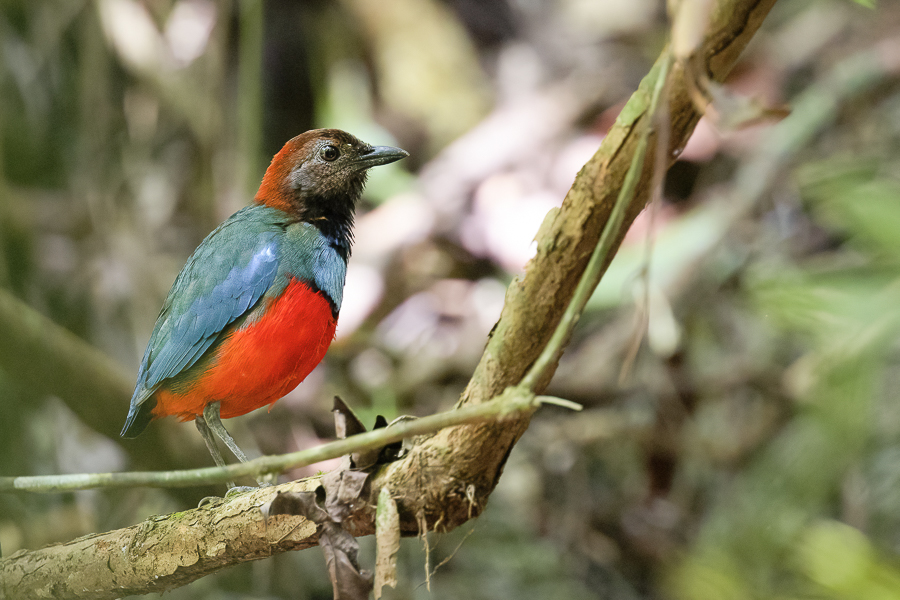Indonesia: Vogelkop West Papua
It is impossible to forget the first time you see a Western Parotia dance, a Black Sicklebill transforming at dawn, or a Wilson’s Bird-of-paradise glowing like fire in the dark forest understory. Throw in Western Crowned Pigeon, Masked Bowerbird, and Red-breasted Paradise Kingfisher? This is the true “Attenborough Experience”, and simply the best birding tour in the world as far as we are concerned! Our itinerary is unique, allowing more time at new sites like Malagufuk, where some of the trickiest birds in New Guinea like Pheasant Pigeon, Thick-billed Ground Pigeon, New Guinea Bronzewing, Red-billed Brushturkey, and Northern Cassowary are almost commonplace.
Next Dates
2 July - 17 July 2026 (16 days)
Leaders:
Joachim Bertrands
Group Size Limit:
7
Single Room Supplement: $
600 USD
Deposit: $
750 USD
Price: $
8600 USD
Add a Title
Leaders:
Joachim Bertrands
Group Size Limit:
Add a Title
Single Room Supplement: $
TBD
Deposit: $
TBD
Price: $
TBD
Add a Title
4 August - 19 August 2026 (16 days)
Leaders:
Joachim Bertrands
Group Size Limit:
7
Single Room Supplement: $
600 USD
Deposit: $
750 USD
Price: $
8600 USD
Add a Title
Leaders:
Joachim Bertrands
Group Size Limit:
Add a Title
Single Room Supplement: $
TBD
Deposit: $
TBD
Price: $
TBD
Add a Title
3 July - 18 July 2027 (16 days)
Leaders:
Julien Mazenauer
Group Size Limit:
7
Single Room Supplement: $
600 USD
Deposit: $
750 USD
Price: $
8800 USD
Add a Title
Leaders:
Julien Mazenauer
Group Size Limit:
Add a Title
Single Room Supplement: $
TBD
Deposit: $
TBD
Price: $
TBD
Add a Title
19 July - 3 August 2027 (16 days)
Leaders:
Donna Belder
Group Size Limit:
7
Single Room Supplement: $
600 USD
Deposit: $
750 USD
Price: $
8800 USD
Add a Title
Leaders:
Donna Belder
Group Size Limit:
Add a Title
Single Room Supplement: $
TBD
Deposit: $
TBD
Price: $
TBD
26 August - 10 September 2027 (16 days)
Leaders:
Donna Belder
Group Size Limit:
7
Single Room Supplement: $
600 USD
Deposit: $
750 USD
Price: $
8800 USD
Add a Title
Leaders:
Donna Belder
Group Size Limit:
Add a Title
Single Room Supplement: $
TBD
Deposit: $
TBD
Price: $
TBD
It is of utmost importance in West Papua to have reliable contacts who can smoothly arrange access to all birding areas and hides. We work with the wonderful Shita Prativi who has been running bird tours and assisting BBC / National Geographic film crews here for longer than anyone else.
Accommodation:
Comfortable hotels for Manokwari, Waigeo, and Sorong. Basic but comfortable guesthouse in the Arfaks (shared facilities), possibly one or two nights in permanent tented camp in the upper Arfaks (shared rooming and facilities), and basic guesthouse at Malagufuk (shared facilities).
Walking difficulty:
Walks and trails are mostly short, however especially in the Arfaks many sections will be steep and/or muddy. As such, good balance is essential and some fitness is recommended if you want to be able to reach every display hide (a couple require quite direct and dedicated predawn hikes of ~1.5 hours). A few longer walks (~3 hours) around Malagufuk will be taken at birding pace with lots of stops.
Tour cost includes:
All accommodation, main meals, drinking water, internal flights (as stated in itinerary), overland transport, tips to local drivers and guides, travel permits, entrance fees, and guide fees.
Tour cost excludes:
Flights before and after the tour start/end, visa, travel insurance, tips to tour leaders, laundry, drinks and other items of a personal nature.


Day 1: Arrival into Manokwari (MKW) and drive up into the Arfak Mountains. Reach our lodgings where we will be based for the next week in the mid-afternoon. Most of our seven nights here will be spent in a basic but pleasant guesthouse in Mingre Village, with one or two nights to be spent at a field camp slightly higher up the mountains to search for more montane specialties.
Days 2-3-4-5-6-7: Perfectly positioned to explore all the different altitudes, we will get started straight away by using the early hours to visit one of the many hides constructed by local villagers, crossing our fingers that we can witness the extravagant ballerina display of a male Western Parotia, the mesmerising dance of a Crescent-caped Lophorina, or the unbelievable stretch of a Magnificent Bird-of-paradise, all at point-blank range! Fruit feeders sometimes attract Black-billed Sicklebill or Arfak Catbird, and if we are lucky the bower of a Masked Bowerbird will have been located, allowing us to intimately observe his iridescent flaming plumage. Higher up, the cryptic endemic Long-tailed Paradigalla is usually outshone by the resident male Black Sicklebill practicing his mesmerising display at dawn – the same individual filmed by the BBC in recent documentaries! Nearby, huge and complex structures of sticks, moss, fruit and colourful trinkets are typically closely watched by unassuming male Vogelkop Bowerbirds, keeping rivals away from their bachelor pads.
We will rely on our skilled Papuan guides to find us bizarre-looking Feline, Mountain and Vogelkop Owlet-nightjars at their day roosts, while an abundance of other exciting birds should include Arfak Astrapia, White-striped Forest Rail, West Papuan Lorikeet, Josephine’s Lorikeet, Red-breasted Pygmy Parrot, White-eared Bronze Cuckoo, Wallace's Fairywren, Orange-crowned Fairywren, Spotted Jewel-babbler, Vogelkop Melidectes, Arfak Honeyeater, Lesser Melampitta, Vogelkop Scrubwren, Goldenface, Papuan Treecreeper, Mottled Berryhunter, Smoky Robin, Green-backed Robin, Grey-banded Mannikin, and many more! Nights in Mingre Village.
Day 8: After a final day of birding in the Arfaks, we return to Manokwari and fly to Sorong for overnight.
Day 9: Today, we head out early to the Malagufuk Village trailhead. At birding pace and with several porters, we will walk into the village, where we are to spend the next three nights.
Day 10-11: This magnificent forest offers the best lowland birding in New Guinea, largely due to the local ban on hunting. The abundance of ground-dwelling species is so extraordinary that every time the trail turns a corner we hold our breath, hoping to come face-to-face with a Northern Cassowary, Red-billed Brushturkey, Pheasant Pigeon, New Guinea Bronzewing, or Thick-billed Ground Pigeon. The mind-blowing Red-breasted Paradise Kingfisher and furtive Blue-black Kingfisher are both common, while Emperor Fairywren, Tawny Straightbill, Spotted Honeyeater, Papuan Babbler, Blue Jewel-babbler, Sooty Thicket-Fantail, Lowland Peltops, Yellow-bellied Longbill, Olive Flyrobin, and Golden Myna are some other great birds we often encounter here. The afternoon skies are filled with endemic Black Lory amongst dozens of other parrot and pigeon species.
We will utilise the mornings to visit display areas of Magnificent Riflebird, Twelve-wired Bird-of-paradise and Lesser Bird-of-paradise, while the tiny King Bird-of-paradise prefers to display in the mid-afternoon. If the nights are clear, your leader will work hard to find not only specialties like Papuan Hawk-Owl, Wallace’s Owlet-nightjar, and Papuan Nightjar, but also some excellent mammals such as Lowland Ringtail, Striped Possum, Brown Dorcopsis, and even Western Long-beaked Echidna, which has recently become reliable here! Nights in Malagufuk Village.
Day 12: Exiting the forest, we will get back to Sorong in time for the fast ferry to Waigeo in the Raja Ampat Islands for a three-night stay by the beach in a relaxing dive resort. Luxury, but there are still many birds to see!
Days 13-14: The island of Waigeo holds two species that stand out from the rest. Wilson’s Bird-of-paradise is perhaps the most ridiculously colourful bird in the world and positively glows in the understorey as we watch from purpose-built hides only metres away from their display areas. In the treetops, male Red Bird-of-paradise form noisy leks and show off their highly-evolved dance moves whenever a female drops by. Western Crowned Pigeon are still common enough here that we should see several, while the endemic Raja Ampat Pitohui and Waigeo Shrikethrush usually don’t take much effort to track down. We sometimes see the scarce White-eared Catbird, but it is never guaranteed.
Several more widespread but nonetheless exciting lowland species are abundant on Waigeo, such as Dusky Scrubfowl, Eclectus Parrot, Palm Cockatoo, Beach Kingfisher, Hook-billed Kingfisher, Rufous-bellied Kookaburra, Papuan Dwarf Kingfisher, Moustached Treeswift, Brown-headed Crow, Glossy-mantled Manucode, Eastern Hooded Pitta, and Papuan Pitta. It is also not unusual for us to bump into the endemic Waigeo Cuscus on our wanderings, while Marbled Frogmouth and Papuan Boobook can be found after dark.
One afternoon we will take a boat trip offshore, where small islet avifauna includes two particularly exciting near-endemics: Violet-necked Lory and Spice Imperial Pigeon. We should also see an abundance of Olive Honeyeater, Varied Honeyeater, Island Whistler, Supertramp Fantail, Lemon-bellied White-eye, and Moluccan Starling. Nights on Waigeo.
Day 15: After a final morning on Waigeo, we return by boat to Sorong for an overnight stay. If time allows, we will search for Blue-fronted Fig-Parrot, Black Thicket-fantail, Orange-fronted Fruit-Dove, and Little Kingfisher at a site near town in the evening.
Day 16: The tour finishes this morning with departures out of Sorong (SOQ).
This tour can be linked with our perfectly-complementing Indonesia: Central West Papua tour for full coverage of the region.
































_JPG.jpg)
%20900x600.jpeg)

